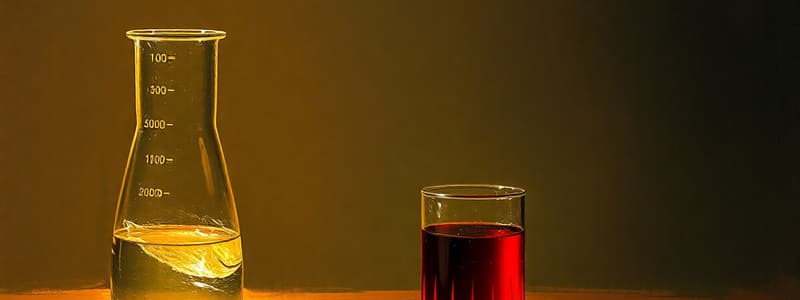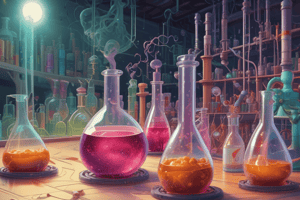Podcast
Questions and Answers
What is the primary function of a volumetric flask?
What is the primary function of a volumetric flask?
- To deliver an exact volume of solution
- To mix different solutions together
- To measure approximate volumes of liquids
- To contain a definite volume of solution (correct)
What must be done to a graduated cylinder before use?
What must be done to a graduated cylinder before use?
- It should be rinsed with deionised water (correct)
- It needs to be dried completely
- It must be calibrated for temperature
- It should be filled with deionised water
When using a volumetric flask to prepare a solution, how is the last few cm³ of water added?
When using a volumetric flask to prepare a solution, how is the last few cm³ of water added?
- Quickly, to prevent evaporation
- Carefully, so the meniscus rests on the calibration mark (correct)
- With a pipette to ensure volume accuracy
- By pouring directly from a bottle
How is a pipette filled with solution?
How is a pipette filled with solution?
What is the purpose of inverting a stoppered volumetric flask after filling it?
What is the purpose of inverting a stoppered volumetric flask after filling it?
What is the concentration of the diluted solution obtained from the equation $250 \times M_{dil} = 15 \times 2$?
What is the concentration of the diluted solution obtained from the equation $250 \times M_{dil} = 15 \times 2$?
What is a primary standard?
What is a primary standard?
Which of the following is NOT a criterion for a substance to be considered a primary standard?
Which of the following is NOT a criterion for a substance to be considered a primary standard?
During the preparation of a standard solution, what is the purpose of rinsing the clock glass with deionised water?
During the preparation of a standard solution, what is the purpose of rinsing the clock glass with deionised water?
What should be done after filling the volumetric flask with the solution almost to the calibration mark?
What should be done after filling the volumetric flask with the solution almost to the calibration mark?
Which of the following steps is essential for ensuring a homogeneous solution?
Which of the following steps is essential for ensuring a homogeneous solution?
What is the mass of pure anhydrous sodium carbonate used to prepare the standard solution?
What is the mass of pure anhydrous sodium carbonate used to prepare the standard solution?
Which of the following actions is NOT part of the mandatory experiment to prepare a standard solution?
Which of the following actions is NOT part of the mandatory experiment to prepare a standard solution?
What is the molar mass of anhydrous sodium carbonate, Na2CO3?
What is the molar mass of anhydrous sodium carbonate, Na2CO3?
What is the purpose of using a primary standard in a titration?
What is the purpose of using a primary standard in a titration?
How many moles of anhydrous sodium carbonate are present in 2.65g?
How many moles of anhydrous sodium carbonate are present in 2.65g?
What is the final step in preparing the volumetric solution from the sugar supply?
What is the final step in preparing the volumetric solution from the sugar supply?
What is the color change of methyl orange indicator at the endpoint of the titration?
What is the color change of methyl orange indicator at the endpoint of the titration?
Which of the following steps is NOT part of the titration process?
Which of the following steps is NOT part of the titration process?
Which reaction occurs when hydrochloric acid is titrated with sodium carbonate?
Which reaction occurs when hydrochloric acid is titrated with sodium carbonate?
What is the importance of reading the burette at eye level?
What is the importance of reading the burette at eye level?
What is the purpose of rinsing the pipette with deionised water before use?
What is the purpose of rinsing the pipette with deionised water before use?
Which step is crucial to prevent splashing when using a conical flask?
Which step is crucial to prevent splashing when using a conical flask?
What should be done if the level of liquid in the burette is above the zero mark after filling?
What should be done if the level of liquid in the burette is above the zero mark after filling?
Why is it important to wait a few seconds before removing the pipette from the flask after discharging the solution?
Why is it important to wait a few seconds before removing the pipette from the flask after discharging the solution?
Why should the burette not be rinsed with the solution it is going to contain?
Why should the burette not be rinsed with the solution it is going to contain?
What should the pipette be rinsed with after deionised water?
What should the pipette be rinsed with after deionised water?
What is an essential characteristic of the conical flask design?
What is an essential characteristic of the conical flask design?
What is the significance of recording the meniscus level at eye level?
What is the significance of recording the meniscus level at eye level?
What does a 10% w/v NaCl solution indicate?
What does a 10% w/v NaCl solution indicate?
How is molarity defined?
How is molarity defined?
What is the correct meaning of 1 ppm?
What is the correct meaning of 1 ppm?
Which of the following statements about a 1 M (molar) solution is true?
Which of the following statements about a 1 M (molar) solution is true?
What does the term 'weight per weight' (w/w) mean?
What does the term 'weight per weight' (w/w) mean?
Which of the following correctly describes a homogenous mixture?
Which of the following correctly describes a homogenous mixture?
What is the purpose of rinsing the burette with diluted vinegar solution before use?
What is the purpose of rinsing the burette with diluted vinegar solution before use?
At what point does the phenolphthalein indicator change color during the titration of vinegar with sodium hydroxide?
At what point does the phenolphthalein indicator change color during the titration of vinegar with sodium hydroxide?
When conducting a titration, why is it crucial to perform multiple titrations?
When conducting a titration, why is it crucial to perform multiple titrations?
What is the expected final concentration of sodium carbonate solution after titration with 0.1 M hydrochloric acid?
What is the expected final concentration of sodium carbonate solution after titration with 0.1 M hydrochloric acid?
Which indicator is used during the titration of sodium carbonate with hydrochloric acid?
Which indicator is used during the titration of sodium carbonate with hydrochloric acid?
What is the effect of efflorescence on hydrated sodium carbonate crystals?
What is the effect of efflorescence on hydrated sodium carbonate crystals?
What is the main reason for inverting the volumetric flask after mixing the diluted vinegar?
What is the main reason for inverting the volumetric flask after mixing the diluted vinegar?
How is the percentage (w/v) of ethanoic acid in the vinegar calculated?
How is the percentage (w/v) of ethanoic acid in the vinegar calculated?
Flashcards
Solution concentration
Solution concentration
The amount of solute dissolved in a given volume of solution.
Weight per weight (w/w)
Weight per weight (w/w)
Grams of solute per 100 grams of solution.
Weight per volume (w/v)
Weight per volume (w/v)
Grams of solute per 100 cm³ of solution.
Parts per million (ppm)
Parts per million (ppm)
Signup and view all the flashcards
Molarity (M)
Molarity (M)
Signup and view all the flashcards
1 M solution
1 M solution
Signup and view all the flashcards
0.85% w/v NaCl
0.85% w/v NaCl
Signup and view all the flashcards
Converting molarity to grams per litre
Converting molarity to grams per litre
Signup and view all the flashcards
Titration
Titration
Signup and view all the flashcards
Graduated Cylinder
Graduated Cylinder
Signup and view all the flashcards
Volumetric Flask
Volumetric Flask
Signup and view all the flashcards
Pipette
Pipette
Signup and view all the flashcards
Making a solution up to the mark
Making a solution up to the mark
Signup and view all the flashcards
Standard Solution
Standard Solution
Signup and view all the flashcards
Primary Standard
Primary Standard
Signup and view all the flashcards
What are the criteria for a primary standard?
What are the criteria for a primary standard?
Signup and view all the flashcards
How is a standard solution prepared?
How is a standard solution prepared?
Signup and view all the flashcards
Why is sodium carbonate used to prepare a standard solution?
Why is sodium carbonate used to prepare a standard solution?
Signup and view all the flashcards
Why is deionized water used?
Why is deionized water used?
Signup and view all the flashcards
Why is the volumetric flask rinsed with water?
Why is the volumetric flask rinsed with water?
Signup and view all the flashcards
Why is the solution inverted after preparation?
Why is the solution inverted after preparation?
Signup and view all the flashcards
Pipette Filler
Pipette Filler
Signup and view all the flashcards
Meniscus
Meniscus
Signup and view all the flashcards
Conical Flask
Conical Flask
Signup and view all the flashcards
Deionised Water
Deionised Water
Signup and view all the flashcards
Methyl Orange Indicator
Methyl Orange Indicator
Signup and view all the flashcards
Efflorescence
Efflorescence
Signup and view all the flashcards
What is a hydrated salt?
What is a hydrated salt?
Signup and view all the flashcards
What is the purpose of standardizing a solution?
What is the purpose of standardizing a solution?
Signup and view all the flashcards
What is a primary standard?
What is a primary standard?
Signup and view all the flashcards
What is a secondary standard?
What is a secondary standard?
Signup and view all the flashcards
What is the purpose of a titration?
What is the purpose of a titration?
Signup and view all the flashcards
What is the end point of a titration?
What is the end point of a titration?
Signup and view all the flashcards
What is a volumetric flask used for?
What is a volumetric flask used for?
Signup and view all the flashcards
Preparing a Standard Solution
Preparing a Standard Solution
Signup and view all the flashcards
Endpoint
Endpoint
Signup and view all the flashcards
Indicator
Indicator
Signup and view all the flashcards
Methyl Orange
Methyl Orange
Signup and view all the flashcards
Study Notes
Volumetric Analysis: Acid-Base
- Volumetric analysis is a quantitative method using solutions.
- A solution is a homogenous mixture of solute and solvent.
- Solution concentration can be expressed in different ways.
Percentage of Solute
- Weight per weight (w/w): grams of solute per 100 g of solution (g/100g).
- Example: 10% NaCl w/w means 10 g NaCl per 100 g solution.
- Weight per volume (w/v): grams of solute per 100 cm³ of solution (g/100 cm³).
- Example: 10% w/v NaCl means 10 g NaCl per 100 cm³ solution.
- Volume per volume (v/v): volume of solute per 100 cm³ of solution (cm³/100 cm³).
- Example: 10% v/v ethanol has 10 cm³ ethanol per 100 cm³.
Parts per Million (ppm)
- Used for very dilute solutions.
- 1 ppm = 1 mg/L
Moles of Solute per Liter of Solution (Molarity)
- Molarity is the number of moles of solute per litre of solution.
- 1 M solution contains 1 mole of solute per litre of solution.
Converting Moles per Liter to Grams per Liter
- To convert moles per liter to grams per liter, multiply by the molar mass.
- Example: 0.25 M NaCl solution contains 14.625 g/L NaCl.
Converting Grams per Liter to Moles per Liter
- To convert grams per liter to moles per liter, divide by the molar mass.
- Exmaple: Solution that contains 3.68 g NaOH per liter of solution is 0.092 M.
Calculating the Number of Moles
- Number of moles = volume × molarity / 1000
- Example: 25 cm³ of 0.55M NaOH contains 0.014 moles NaOH.
Dilution of Solutions
- Moles of solute in diluted solution = Moles of solute in concentrated solution.
- (Volume of diluted solution)(Molarity of diluted solution)/1000 = (Volume of concentrated solution)(Molarity of concentrated solution)/1000
- Example: 250 cm³ of 12 M HCl to make 500 cm³ of 3 M HCl requires 100 cm³ of 12M HCl.
Reaction between a Solution and a Solid
- Example: Mass of magnesium that reacts with 50 cm³ of 0.5 M H₂SO₄ is 0.6 g.
Standard Solutions
- Standard solution: A solution with accurately known concentration.
Primary Standard
- Primary standard: A pure, stable and soluble solid that can be weighed to accurately prepare a solution.
Mandatory Experiment: Preparing a Standard Solution of Sodium Carbonate
- Detailed steps for preparing a standard sodium carbonate solution.
Volumetric Analysis: Titration
- Definition: Measurement of one solution with another.
- Titration apparatus: Graduated cylinders, Volumetric flasks, Pipettes, Conical Flask.
The Pipette:
- Exact volume measurement.
- Using a pipette filler.
Conical Flask:
- Designed for swirling.
- Should not be washed directly with solution.
Mandatory Experiment: Standard Solution of Sodium Carbonate to Standardize Hydrochloric Acid Solution
- Detailed step-by-step procedure of titration experiment
Mandatory Experiment: Determining Ethanoic Acid in Vinegar
- Detailed steps for calculating concentration of ethanoic acid in vinegar.
Mandatory Experiment: Determining the amount of water of crystallisation in hydrated sodium carbonate
- Steps for finding the amount of water of crystallisation of sodium carbonate.
Exam Questions (2014)
- Detailed analysis of exam questions pertaining to washing soda crystals.
Studying That Suits You
Use AI to generate personalized quizzes and flashcards to suit your learning preferences.
Related Documents
Description
This quiz covers the fundamentals of volumetric analysis, focusing on acid-base solutions. You'll learn about various ways to express solution concentration, including weight/weight, weight/volume, and molarity. Test your understanding of these concepts and improve your analytical skills.




